When talk turns to Japanese dominance at Australia’s most famous racetrack, it’s likely to be Nissan that springs to mind.
And not without reason: after all, its R32 GT-R won back-to-back Bathurst 1000s in 1991 and 1992, before adding to the tally in 2015 with victory in the Bathurst 12-Hour with its R35 GT-R GT3.
But as Nissan’s dominance of the Australian Touring Car Championship came to an end in 1992, another Japanese manufacturer was forging a Bathurst legacy of its own. Ironically, it was Nissan’s success at Australian motorsport’s highest level that opened the door for Mazda to establish itself as a major player at Mount Panorama.
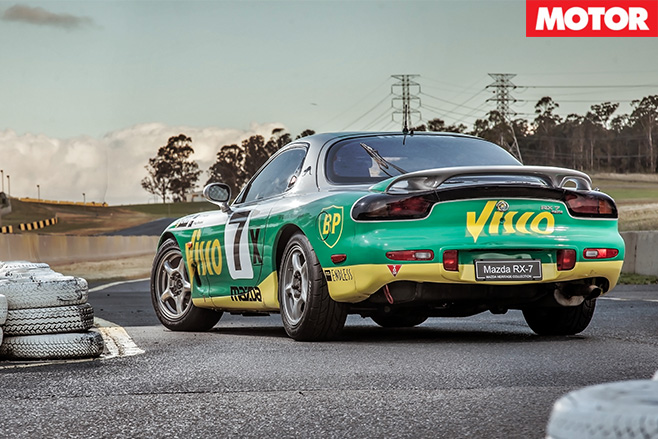
Despite a short lead-up, the first race attracted a stellar cast, with luminaries such as Colin Bond, Peter Brock and Kent Youlden driving semi-factory cars from Toyota, Holden and Ford respectively. Peter Fitzgerald, Allan Grice and Nigel Arkell won the inaugural event in a Toyota Supra Turbo.
The successful debut led to a huge surge in interest, with entries exploding from just 24 in 1991 to over 50 for 1992. Many of these were with official manufacturer support, including BMW, Ford, Peugeot, Citroen (yes, really), Saab (yes, REALLY!) and, of course, Mazda.
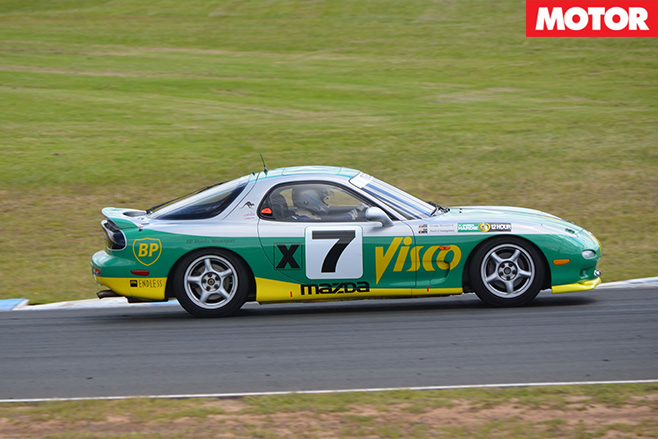
Mazda’s line-up was lower key, with John Bowe and Gregg Hansford driving the number seven car and Charlie O’Brien, Garry Waldon and Mark Gibbs sharing number 17. Their steeds would be the newly-introduced third-generation RX-7.
Mazda motorsport manager, Allan Horsley, had driven the car in Japan and deemed it the perfect platform on which to mount a Bathurst challenge. “I test drove it at a circuit over there just to see what it was like, which was brilliant, and from there we decided to race it,” Horsley recalls.

The car proved an ideal match for long-distance production car racing, taking three straight wins at the Bathurst 12-Hour from 1992-’94 and another in SP form in 1995 when the event moved from Bathurst to Eastern Creek.
The car pictured here is the winner from 1994 that was driven by Neil Crompton and Gregg Hansford. Crompton’s a bit like Australia’s version of Martin Brundle – an extremely accomplished racing driver who is now perhaps better known for his broadcasting abilities.
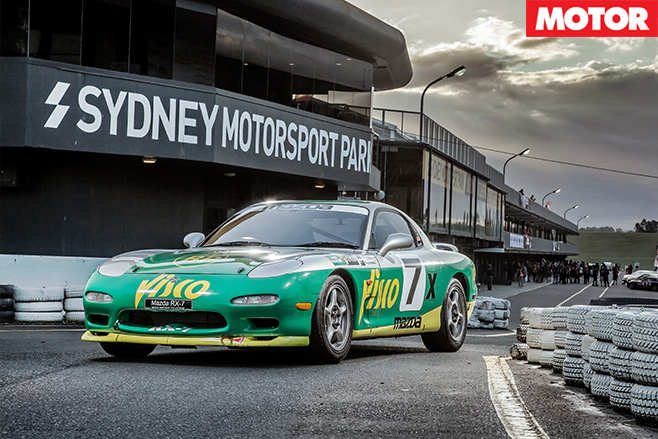
Unsurprisingly, given its winning pedigree, Crompton has fond memories of the little Japanese sportscar. “It was really good actually; its handling behaviour was very, very good. Everything from pretty much The Cutting to Forrest’s Elbow was just fabulous.” Horsley agrees. “The strong points were that you could drive it flat all the time, just never back off.”
Thankfully, we don’t need to take their word for it, as Mazda chucked MOTOR the keys to its thoroughbred for a quick session at Sydney Motorsport Park. And it will be quick in both meanings of the word, as while we have an unrestricted track in front of us, our time with the car is limited to five minutes. Best get going then.

Thumbs up from the marshal and a clear track awaits. We’ve just an out lap and an in lap, so no time to waste. Thankfully, the car is already warm so the accelerator meets the carpet as we exit pit lane. First impressions are that while it might have been considered almost a ‘supercar’ in the early 90s, by today’s standards the RX-7 is not a particularly fast car.
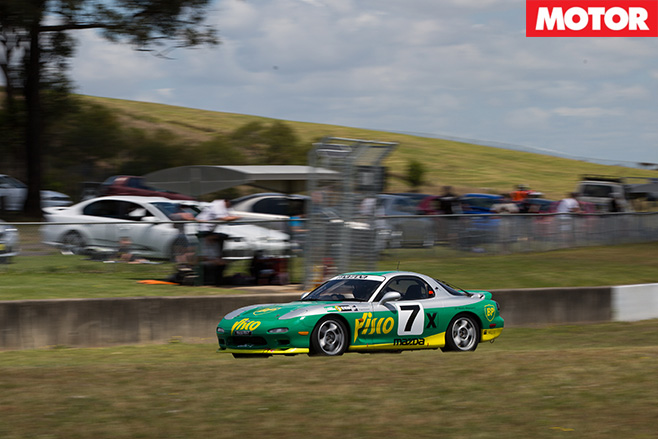
Unsurprisingly, MOTOR tested the RX-7 on a number of occasions when new, recording 0-100km/h in 6.29sec and 0-400m in 14.56sec at 154.1km/h in a January 1993 comparison test against the Mitsubishi 3000GT, Nissan R32 GT-R and Nissan 300ZX.
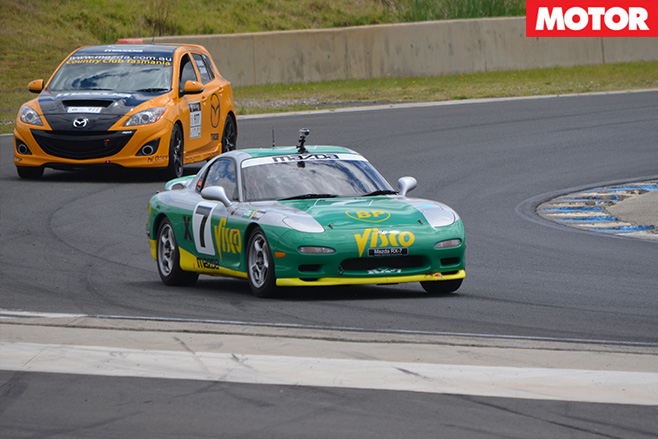
Crompton also remembers that while the car had plenty of strengths, straight-line pace wasn’t one of them. “No, it certainly didn’t whip the head back when you stood on the throttle, but what you had to do was drive it like a smaller capacity car. It was all about rolling speed, so if you allowed it to bog down…that was going to cost you lap time.”
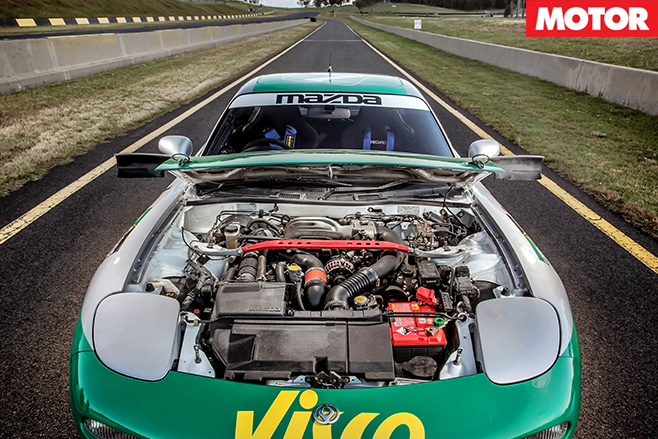
By now we’re approaching turn one and the first turn of the steering wheel is all it takes to suggest that this RX-7 might be the friendliest car I’ve ever driven at speed.
Any concerns about not being able to exploit the car in the allotted time immediately evaporate as the lightweight Mazda pours itself into the long, sweeping turns of SMP’s GP circuit with perfect balance.
It’s rare that you drive a car on track and don’t need to make allowances; perhaps you have to be careful not to induce understeer, or maybe lots of power makes wheelspin and oversteer a constant threat.
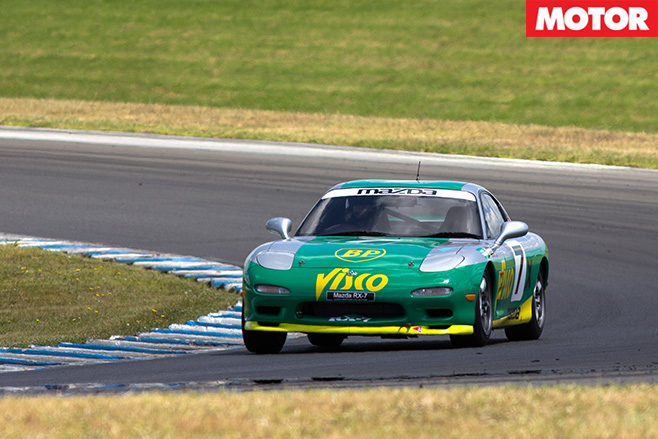
“[The RX-7 was] obviously very good in its baseline weight distribution, but we did a lot of work to make it driver-friendly. I couldn’t honestly tell you how many test days we did… we’d just trundle out to Oran Park and pound around with the car.”
Crompton remembers that the only aspect of the car that needed care was the brakes. “They were quite good, but you couldn’t just jam your size 10 on them or eventually they’d suffer.” Unusually, the ABS was left connected, as Horsley says that even with the stellar driving cast he’d assembled, the car was a lot slower with it disconnected.
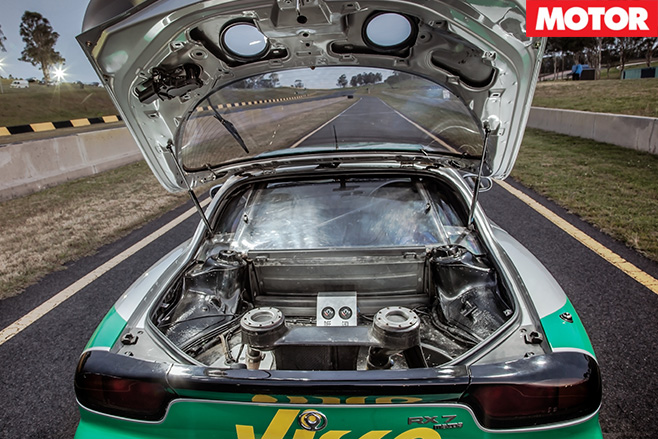
The sight of the chequered flag is a crushing disappointment, as this tantalising taste of the RX-7’s abilities has been enough to crave more time behind the wheel of Mazda’s only real high-performance sportscar. Another 11 hours and 55 minutes should be just about sufficient.
4.5 out of 5 stars
| u00a0 | MAZDA RX-7 |
| Body | 2-door, 2-seat coupe |
| Drive | rear-wheel |
| Engine | 1308cc twin-rotor, twin-turbo |
| Bore/Stroke | N/A |
| compression | 9.0:1 |
| power | 176kW @ 6500rpm |
| torque | 295Nm @ 5000rpm |
| power/weight | 134kW/tonne |
| transmission | 5-speed manual |
| weight | 1310kg |
| Suspension | double A-arms, coil springs, anti-roll bar |
| L/W/H | 4280/1750/1230mm |
| Wheelbase | 2425mm |
Tracks | 1460/1460mm (f/r) |
| Steering | hydraulically-assisted rack-and-pinion |
| Brakes | 294mm ventilated discs, 4-piston calipers (f); 294mm ventilated discs, single-piston floating calipers (r) |
| Wheels | 16 x 8.0-inch (f/r) |
| Tyres | 225/50 R16 92V (f/r); Direzza Sport D1 |
| Price | $73,000 (1993) |
| Positives | Perfect chassis balance; incredible communcation; provenance |
| Negatives | Not particularly fast; we didnu2019t get to drive it for 12 hours straight |





